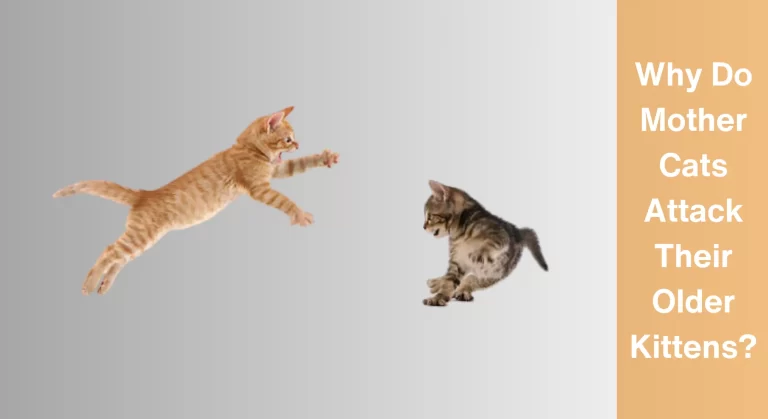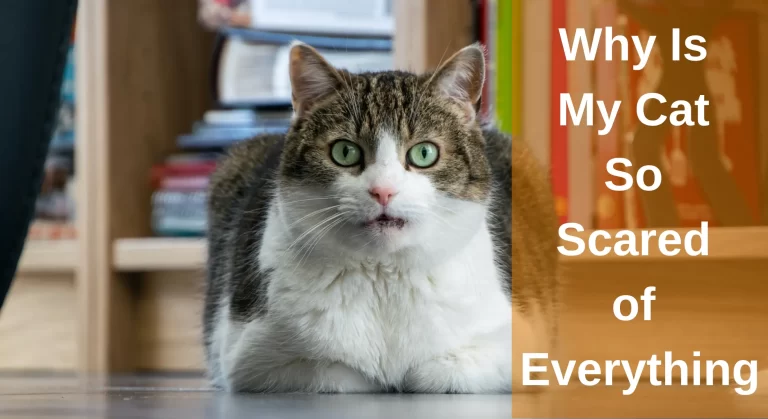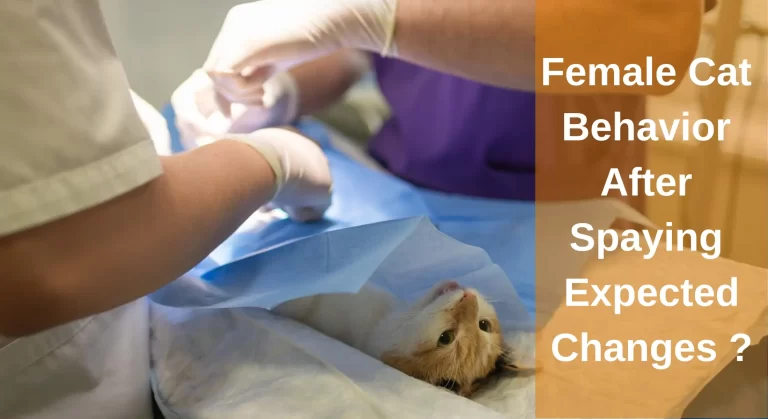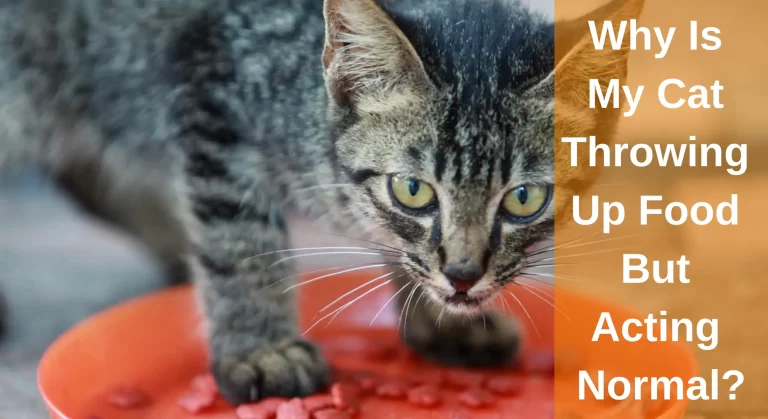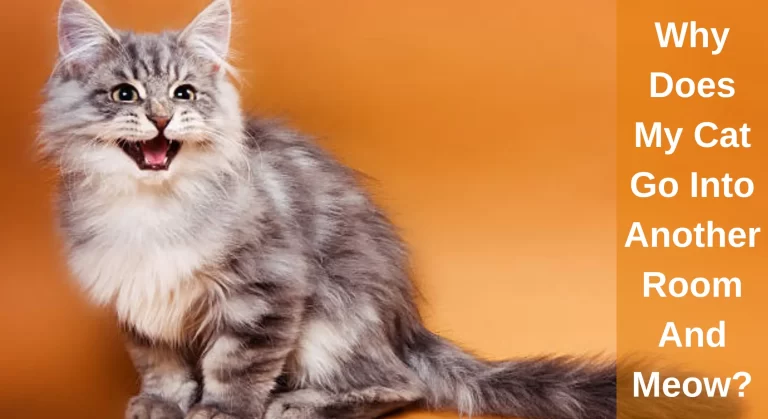Why Does My Cat Paw at Her Water Bowl? Interesting Reasons
The behavior of cats can sometimes seem puzzling, and it is no wonder why they are such mysterious creatures. Cat owners often observe their feline friend pawing at the water bowl. If you’ve noticed your cat doing this, you may wonder, “why does my cat paw at her water bowl” and whether it’s a cause for concern.
Cats paw at their water bowl for various reasons, including instinctual behavior, hygiene, feeling comfortable, playfulness, or medical issues.
While this behavior may seem odd or annoying, it’s essential to understand why cats do this and how to ensure they stay hydrated. This article will explore the reasons behind your cat’s pawing behavior and what you can do to encourage healthy hydration habits.

Reasons Why Does My Cat Paw at Her Water Bowl
It’s possible that you’ve seen cats putting their paws into the water to drink it. Here are possible reasons why your kitten is showing this behaviour. This may be due to the following:
1. Instinctive Behavior
Cats are natural hunters and predators, and their instincts tell them to be wary of still water. In the wild, stagnant water can be a breeding ground for bacteria and other harmful organisms, so cats are naturally cautious about drinking from it.
Domesticated cats may exhibit similar behaviors, and pawing at their water bowl may be a way to test the water’s safety or release pent-up energy.
By pawing at their water bowl, your cat is trying to simulate the movement of running water, which is more appealing and safer to drink. Additionally, the motion of pawing at the water can stimulate their hunting instincts and provide a fun mental and physical challenge.
2. Preference for Moving Water (Fresh Water)
Another reason why your cat may be pawing at her water bowl is that she prefers moving water. In nature, standing water is more likely to harbor harmful bacteria, so cats have evolved to seek out flowing streams and other sources of moving water.
By pawing at the water, your cat may be trying to create a movement to simulate a flowing stream.
Like humans, cats prefer to drink fresh, clean water. It’s possible that your cat’s water bowl is stale or contaminated with bacteria if it’s been out for a while. Cats may be pawing at the water to tell you that they want fresh water by pawing at it.
3. They Find It Difficult to See The Water Level
If you see your cat putting its claws into the water shortly before drinking any water, it’s probably trying to gauge the water level. Although cats have good vision, they have trouble seeing stationary water.
To make it more visible, they start tapping on it with their paw; as a result, it turns into flowing water. Try to fill the dish consistently at the same level for your cat’s convenience.
4. They’re Having Fun
Due to their high level of activity, kittens will occasionally begin producing intriguing splashes in their water bowl simply for fun. Some cats love the water and have a lot of fun playing in it, especially energetic kittens who are still getting used to their new surroundings.
A kitten at your house that isn’t afraid of the water is usually just playing and having a nice time.
This behavior is usually harmless but can be messy, so you may want to consider using a spill-proof water bowl or placing a mat under the bowl to catch any spills.
5. Health Issues
While pawing at the water bowl can be a harmless quirk, it can also indicate underlying health concerns. If your cat is pawing at the water bowl excessively, it may be a sign of:
- Dental pain or discomfort: Cats with dental problems may have difficulty drinking from the water bowl and may paw at the water in an attempt to make it easier to drink.
- Dehydration: If your cat is not drinking enough water, she may paw at the water bowl in an attempt to encourage herself to drink more.
- Kidney disease: Cats with kidney disease and hyperthyroidism may paw at the water bowl due to increased thirst and dehydration.
If you notice a sudden change in your cat’s drinking behavior or excessive pawing, it’s crucial to consult with your veterinarian.
Also Read: How to Get Your Cat to Drink More Water
6. Uncomfortable Bowl Placement
Considering cats are picky creatures, where their water bowl is located may not appeal to them. If they feel unsafe or uncomfortable in the current location, they may paw at the bowl to express their displeasure.
For example, if the bowl is too close to her food or in a high-traffic area, she may feel uncomfortable drinking and paw at the bowl as a way to express her discomfort.
7. Stress and Anxiety
To express their tension and nervousness, cats may use water splashing. Many cats experience separation anxiety, which frequently shows itself as strange behaviors like splashing the water. Your feline friend will tap the water and make a mess if she needs your attention or she misses you.
8. They Feel Safe Themselves
Felines keep their heads high while drinking water from their paws. You may prevent this by placing several water bowls in less-trafficked places in your home so the cat can have some peace and quiet.
Also, Check Out: My Cat Looking At Water But Not Drinking Why?
Should I be Worried if My Cat Paws at their Water Bowl or Fountain?
If your cat paws at its water bowl or fountain, it is usually not a cause for concern. Many cats do this as a way to test the water’s level or temperature or to create ripples in the water that they find interesting. However, notice excessive pawing or digging at the water bowl or fountain. It could be a sign that your cat is experiencing discomfort or dissatisfaction with their current water source.
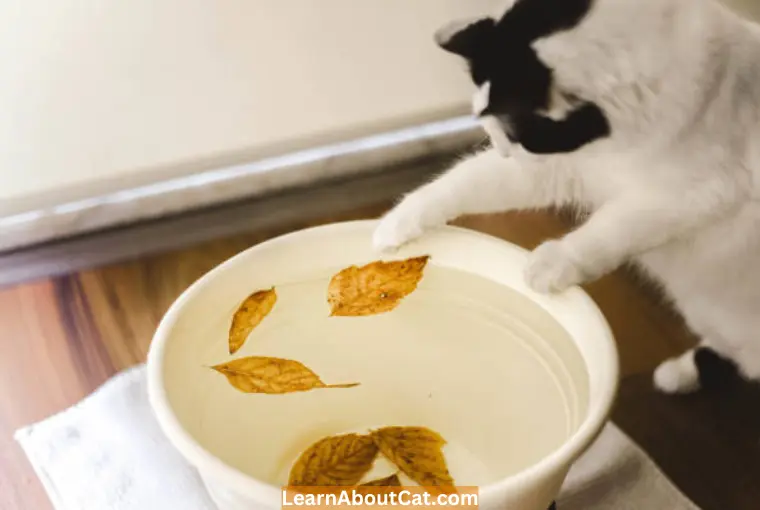
In some cases, pawing at the water bowl can also be a sign of a medical issue, such as dental pain, discomfort, dehydration, kidney disease, or an overactive thyroid gland. It is important to monitor your cat’s behavior and make note of any changes in their drinking habits or behavior.
If you are concerned about your cat’s behavior or health, it is always best to consult with your veterinarian to rule out any underlying health concerns. They may recommend a dental exam or blood work to check for kidney disease or other health issues.
In the meantime, you can encourage your cat to drink more water by providing fresh water, offering a variety of water sources, and adding flavor to their water if needed. By staying attentive to your cat’s behavior and health, you can help ensure they stay happy and healthy.
How Can I Stop My Cat from Pawing at their Water Bowl?
Obviously, it can be annoying to have a cat who regularly splashes water out of her drinking bowl. Therefore, the best course of action is to get rid of the things that cause cats to splash water and encourage them to live more calm lives. This behaviour can be changed in one of the following ways.
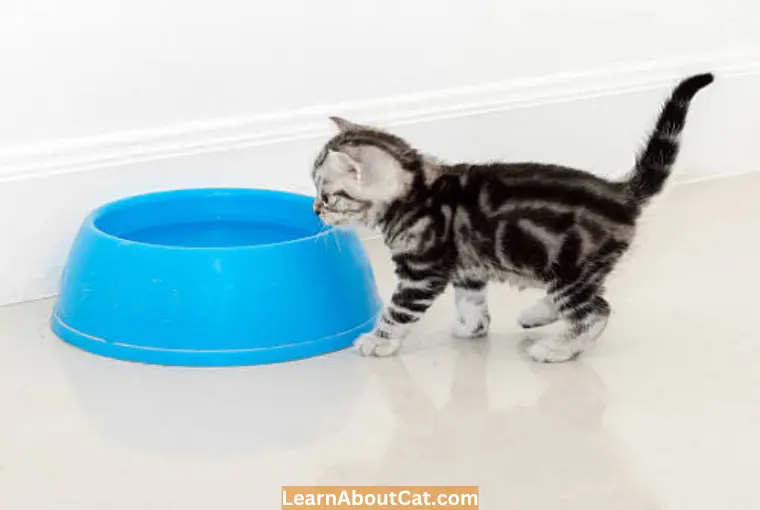
1. Buy a Water Fountain
The simplest way to stop your cat from tipping the water dish over is to buy a high-quality water fountain, and some cats prefer running water, so consider investing in a pet fountain.
Water that is continually flowing and clean is available from fountains. This will encourage your cat to drink more water and prevent them from pawing at the bowl.
2. Clean the Bowl and Provide Fresh water
Cats have a sensitive sense of smell and may refrain from drinking from dirty bowls. Clean the bowl regularly to prevent any buildup of bacteria or dirt.
Cats also prefer fresh, clean water, so ensure they have a fresh bowl of water every day.
Check Out: Why is My Cat Drinking a Lot of Water and Meowing?
3. A spill-Proof Bowl
If your cat pushes the water bowl across the floor or plays with it and makes a mess, think about buying spill-proof cat water dishes.
They feature different designs, are weighted, cannot tip over, and are non-slip. Through these spill-proof bowls, water will not move out of the bowl.
3. Use a Different Water bowl
Consider switching to a ceramic or stainless steel bowl if your cat is pawing at a plastic water bowl. Plastic bowls can harbor bacteria and cause acne on a cat’s chin, which may discourage them from drinking.
Additionally, some cats may prefer drinking from a certain type of bowl, such as a shallow or wide bowl. Trying out different bowls will help you determine which one works best for your cat.
4. Provide a Separate Water bowl for Play
Some cats may paw at the water out of boredom or playfulness. You can provide a separate water bowl or fountain for them to paw at and play with while keeping their primary water source clean and accessible for drinking.
5. Eliminate Stressful Situations
Undoubtedly, a happy cat would be a loving and delightful pet. The mental health of our feline friends is important, so one should concentrate on controlling and getting rid of stressful elements.
You can keep her content and more active by giving your cat buddy regular meals, cleaning her litter box, and giving her access to fresh, clean water.
4. Visit the Vet
If cats exhibit unusual behaviour, it is always best to seek medical assistance. We all know that cats splash and tap water out of their bowls, but if this behaviour is accompanied by other odd behaviours, such as excessive drinking, jitteriness, or stress, the cat may need to visit the vet.
Why Do Cats Paw Around Their Water Dish? – The Risks
While pawing around their water dish may seem harmless, there are potential risks associated with the behavior:
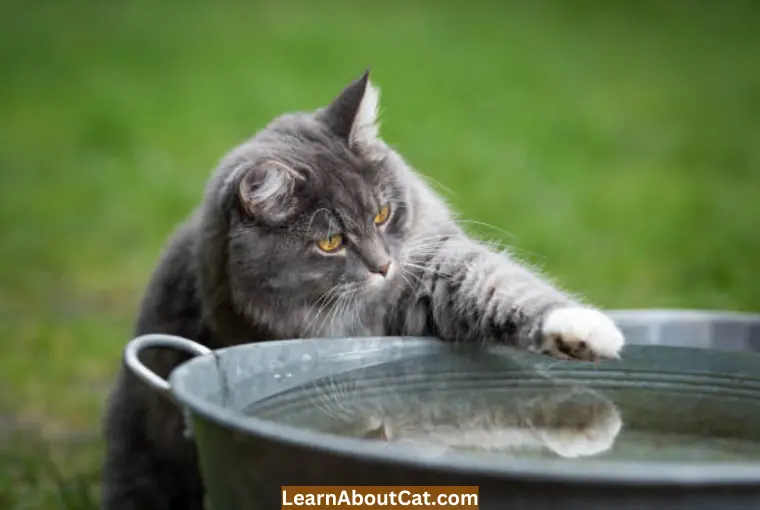
- Spilling – Cats may accidentally spill their water bowl or splash water onto the floor while pawing around their water dish, which can lead to slips and falls.
- Contamination – If the water dish is not cleaned regularly, dirt and debris may accumulate around the bowl, leading to contamination of the water and potentially causing health issues for your cat.
How Can Cats be Kept Out of Water?
- Put less water in your cat’s bowl so he can drink it easily.
- Investing in a weighted water dish is the greatest approach to discourage habitual spillers. These are frequently constructed of stainless steel or ceramic and will stay in place due to their weight.
- Be sure to use a large, shallow dish to avoid whisker fatigue.
- Setting up a feeding station with food and water is another option. The high back and sides contain any spills, and any extra water is filtered into a tray.
- Remove the tray and the water when your cat has finished eating. You must replace your pet’s water at least once a week unless you have a pet water fountain that takes care of this for you.
- The best pet water fountains offer the best guarantee that your cat will always have access to fresh, running water. In addition to being sturdy, a pet water fountain avoids the accessibility issues that a bowl raises.
- Cleaning up is simpler, and you can immediately gather any spilled water if you place a tray beneath your cat’s drinking bowl.
Frequently Asked Questions
Is it normal for cats to paw at their water bowl?
Yes, pawing at the water bowl can be a normal behavior for cats. However, excessive pawing or digging may indicate underlying health concerns.
What kind of water bowl is best for cats?
A shallow bowl or one made of ceramic or stainless steel may be more appealing to cats. Plastic bowls can harbor bacteria and cause acne on a cat’s chin.
How often should I clean my cat’s water bowl or fountain?
You should clean your cat’s water bowl or fountain daily to prevent bacteria or mold growth.
My cat doesn’t like drinking from a bowl. What can I do?
Try offering your cat water from different sources, such as a water fountain, a dripping faucet, or even a glass of water. If the water bowl is not in the right place, It may be a good idea to move the water bowl.
How can I tell if my cat is dehydrated?
Signs of dehydration in cats include dry gums, loss of skin elasticity, lethargy, and decreased appetite. Contact your veterinarian right away if your cat appears dehydrated.
Can I leave my cat’s water fountain running all the time?
Yes, you can leave your cat’s water fountain running all the time. It is designed to do so and can provide fresh, filtered water to your cat throughout the day. Just make sure to clean it regularly.
Final Words!
Pawing at their water bowl or fountain may be a sign of contentment and enjoyment, but it may also be a sign of discomfort. Cats with whisker fatigue have very sensitive whiskers that respond negatively to even the slightest contact.
Providing fresh, clean water is essential, and experimenting with different locations for the bowl will help them avoid this occurrence behavior. If you notice any accompanying symptoms, it’s best to consult a vet. With these tips, you can ensure your cat is happy and hydrated without the need for pawing at their water bowl.
Who is Isabella?
My name is Isabella, and I am a dedicated and knowledgeable cat enthusiast. With years of experience caring for cats and a deep love for felines, I made a mission to help other cat lovers navigate the challenges of cat ownership.

